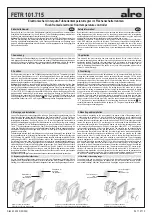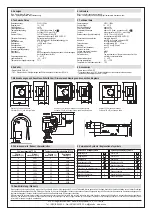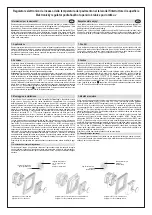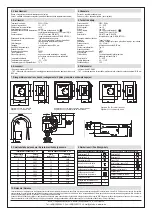
FETR 101.715
Stand 3.2020 (20/024)
5 21 127 10
Elektronischer Unterputz-Fußbodentemperaturregler im Flächenschalterrahmen
Flush framed electronic floor temperature controller
No persons other than expert electricians only must open this device in due compliance with the
wiring diagram shown in the housing cover / on the housing / represented in the corresponding
operating instructions. All expert electricians committed to the execution of any such works must
comply with the relevant safety regulations currently operative and in force.
Caution!
The operation of the controller in the vicinity of other devices that do not comply wi-
th the EMC directives may affect its functions. The company charged with the installation of
the device must, after the completion of the installation works, instruct the user of the control
system into its functions and in how to operate it correctly. These operating instructions must
be kept at a place that can be accessed freely by the operating and/or servicing personnel in
charge.
Sicherheitshinweis!
D
Safety information!
GB
Dieses Gerät darf nur durch eine Elektrofachkraft geöffnet und gemäß dem entsprechenden
Schaltbild im Gehäusedeckel / auf dem Gehäuse / in der Bedienungsanleitung installiert wer-
den. Dabei sind die bestehenden Sicherheitsvorschriften zu beachten.
Achtung!
Der Betrieb in der Nähe von Geräten, welche nicht den EMV-Richtlinien entsprechen,
kann zur Beeinflussung der Gerätefunktionen führen. Nach der Installation ist der Betreiber,
durch die ausführende Installationsfirma, in die Funktion und Bedienung der Regelung einzu-
weisen. Die Bedienungsanleitung muss für Bedien- und Wartungspersonal an frei zugänglicher
Stelle aufbewahrt werden.
1. Anwendung
1. Application
This electronic two-point controller has been specially devised for the control of electric or
warm-water heating systems, additional floor heating systems and other surface temperature
equalization systems. Regarding other applications not to be foreseen by the manufacturer of
this device, the safety standards concerning these applications need to be followed and ad-
hered to. Regarding the aptitude of the device for any such other application, please refer to
section 10. herein (Warranty).
Dieser elektronische Zweipunktregler wurde speziell zur Regelung elektrischer oder Warmwas-
ser-Heizungen/Zusatzheizungen für Fußböden und anderer Oberflächentemperiersysteme ent-
wickelt. Für andere vom Hersteller nicht vorherzusehende Einsatzgebiete sind die dort gültigen
Sicherheitsvorschriften zu beachten. Eignung hierfür siehe Punkt 10. Gewährleistung.
3. Montage und Installation
3. Mounting and installation
2. Funktion
Der Regler misst mit einem in den Fußboden eingebrachten Fühler die Temperatur und regelt
diese mit einer Schaltdifferenz von ca.1K auf den eingestellten Sollwert. Aus dieser Regelung
ergibt sich eine Oberflächentemperatur, die hauptsächlich durch den Aufbau des Fußbodens
bestimmt wird. Bei elektrischen Heizungen ist darauf zu achten, dass diese auch bei Dauerbe-
trieb den Oberflächenaufbau nicht überhitzen können.
Achtung!
Bei Oberflächen, ausgeführt als Sitzmöbel oder Stellfläche, ist darauf zu achten, dass
die eingestellte Temperatur nicht zu einer Gesundheitsgefährdung von Personen oder Entflam-
mung von Gegenständen führen kann. Zur Vermeidung einer zu hohen Temperatureinstellung,
kann der Einstellbereich mechanisch unter dem Einstellknopf eingeschränkt werden (vgl. Punkt
3.1). Der FETR 101.715 verfügt über einen EIN/AUS-Schalter mit dem die Regelung außer Be-
trieb genommen werden kann. Die rote Lampe zeigt die aktive Heizung an. Bei Fühlerbruch,
Fühlerkurzschluss oder einer Fühlertemperatur unter -15°C (entspricht Fühlerbruch) wird die
Heizung ausgeschaltet. Wird an der Klemme die Phase geschaltet, senkt der Regler den
eingestellten Sollwert um ca. 5K ab. Die grüne Lampe zeigt diesen Energiesparmodus an.
Je nach Gerätetyp oder Verpackungsgröße, wird das Gerät entweder geschlossen oder der
schnelleren Montage wegen geöffnet ausgeliefert. Das Gerät mit dem 50 x 50 mm Gehäuse-
deckel ist mittels Zwischenrahmen der Schalterhersteller nach DIN 49075 in nahezu alle Schal-
terprogramme integrierbar. Das Gerät mit dem 55 x 55 mm Gehäusedeckel ist ebenfalls für
diverse Schalterprogramme geeignet. Bei Mehrfachrahmen ist der Regler immer an unterster
Stelle zu montieren. Für die Befestigungsschraube ist je nach verwendeter Schraube ein PZ
1 bzw. T7 Schraubendreher zu verwenden. Zum Öffnen des Reglers ist die Schraube nach Ab-
ziehen des Einstellknopfes zu lösen und die Reglerkappe inklusive Rahmen abzunehmen. Nach
elektrischem Anschluss und Montage in die UP-Dose, ist der Regler in umgekehrter Reihenfol-
ge wieder zu schließen.
Fühlerleitungen müssen aus Sicherheitsgründen und um einen Austausch eines defekten Füh-
lers zu gewährleisten im Schutzrohr verbaut werden. Der mitgelieferte Fühler verfügt über eine
H03VV-Leitung. Die nach EN 60730-1 vorgeschriebene doppelte Isolierung ist bei einer Fühler-
verlängerung mit H03VV-, oder H05VV-Leitungen, auch an den Verbindungsstellen einzuhalten.
Es ist darauf zu achten, dass die Fühlerleitung nicht parallel zu netzspannungsführenden Lei-
tungen verlegt wird. Ist die Parallelverlegung nicht zu vermeiden, muss eine geschirmte Leitung
verwendet und der Schirm auf die Fühlermasse gelegt werden. Zum Verschließen des Schutz-
rohres im Estrich wird die Schutzhülse THF verwendet (vgl. Punkt 6. Zubehör). Um eine optima-
le Wärmeverteilung im Fußboden zu erreichen, muss der Fühler mittig zwischen zwei Heizlei-
tern positioniert werden. Bei Warmwasser-Beheizten Oberflächen sind stromlos geschlossene
Ventile zu verwenden.
Gegebenenfalls benötigte Temperaturbegrenzungen müssen zusätzlich installiert werden
3.1. Begrenzung des Einstellbereichs
Um den Einstellbereich Einzuengen, wird der sich unter dem Einstellknopf befindliche Stift ab-
gezogen und die Einstellfahnen verstellt (rot für maximal und blau für minimal mögliche Ein-
stellung). Anschließend wird der Stift wieder eingesteckt und somit die Begrenzungen arretiert.
Pin for the setting of
the max.
temperature value
Pin for the setting of
the min.
temperature value
Einstellfahne für
maximalen
Temperaturwert
Einstellfahne für
minimalen
Temperaturwert
Regler 50 x 50 mit Alre-Rahmen
Controller (50 x 50) with Alre type frame
Regler 50 x 50 mit Beispiel-Rahmen und Zwischenrahmen
Controller (50 x 50) with sample frame and intermediate frame
Regler 55 x 55 mit Beispiel-Rahmen
Controller (55 x 55) with sample frame
2. Functioning
The controller measures, based on the data delivered to it by a sensor installed in the floor, the
existing floor temperature and controls it with a switching difference of approx. 1K. The control
operations thus performed result in a surface temperature which is mainly determined by the
structure and composition of the related floor. With electric heating lines care must be taken to
ensure that they cannot superheat the surface structure, even if operated continuously.
Caution!
With heated surfaces that have been designed as sitting furniture or that provide special
storing surfaces, care must be taken to ensure that the adjusted temperature does not lead to
health risks or to the inflammation of objects. The setting range of the device can, in order to
prevent from the setting of temperatures that are too high, be restricted mechanically by means
of a special facility that exists underneath of the adjusting knob (see section 3.1). The FETR
101.715 is equipped with an ON/OFF switch that enables to activate or deactivate its control
operations. The active state of the heating system is indicated by the red lamp that has been
provided for this purpose. The heating system is deactivated in the event of a sensor break-
down or sensor short-circuit and also in the event the sensor measures a temperature below
-15°C (equivalent to a sensor breakdown). When connecting the phase to the terminal , the
controller decreases the adjusted set value by approx. 5K. The green lamp indicates the active
state of this energy economizing mode.
The controller is, depending on the type version of the device or size of the package used for
it, either delivered in closed or, in order to facilitate its fast installation, also in opened conditi-
on. The device with the 50 x 50 mm housing cover can be integrated into almost all currently
available flush switch installation frame systems when using DIN 49075 compliant intermediate
frames. The device with the 55 x 55 mm housing cover is also suited for use with different com-
mercially available switch lines. If using multiple frames, the controller must always be mounted
in the lowest position. Depending on the type of screw used, either a PZ1 or T7 screwdriver is
to be used for the fastening of the cover fixing screw. The controller can be opened after the
removal of the adjusting knob. Once this has been done, a screwdriver must to be applied to
loosen the screw that is visible now. After that, the controller cap can be removed along with the
frame. After its electrical connection and installation in an UP box, the housing can be closed
again in inverse order. For safety reasons and in order to ensure that defect sensors can be
replaced easily, the sensor lines need to be installed in a protective tube. The accompanying
sensor is equipped with a H03VV line. When extending the sensor using a H03VV or a H05VV
line, the double insulation required by EN 60730-1 is to be observed at the connecting points as
well. Care must be taken to ensure that sensor lines are not laid in parallel to line voltage car-
rying cables or lines. Where parallel laying cannot be avoided, a shielded line must be used and
the shielding be connected to the sensor mass. The protective sleeve type THF serves for the
closing of the protective tube concealed in the floor screed (see section 6., “Accessories”). To
attain an optimal distribution of the heat across the floor, the sensor should be positioned cen-
trally between two heating conductors. With hot water heated surfaces, normally closed valves
are to be used. Possibly required temperature limiters need to be installed in addition.
3.1. Limitation of the setting range
The setting range can be limited by removing the pin that exists underneath of the adjusting
knob and by adjusting the setting pins as needed (red pin for maximum and blue pin for mini-
mum possible setting). After that, the pin needs to be plugged in again in order to fix the limits.






















